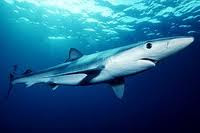The blue shark is my personal favourite of all sharks. It's extremely quick, very well camouflaged and super intelligent. The blue shark is the second quickest shark known to man, losing out only to the mighty shortfin mako shark. The blue shark migrates further than any other shark each year, circulating the Atlantic to feed and to mate. It can swim at speeds of 60kph (40 mph).
Blue sharks spend most of their time about 200 metres down from the surface where they can normally find an abundant supply of mackerel, cod and tuna. Blue sharks feed on fish such as mackerel, cod and tuna but also eat squid and lobsters. Squid is a blue shark's favourite food.
Blue sharks used to be a well populated species but due to trawling, habitat loss, accidental capture and hunting, these sharks, are no longer the hunters but the hunted.
5 000 000 blue sharks are caught each year, the majority of which die. Therefore, the number of blue sharks is now declining rapidly.
When a blue shark finds a large group of small fish (anchovies, sardines etc...) they speed through with their mouths open to eat as many fish at once. Like most big sharks, the blue shark often forces itself to be sick so it can continue eating. The sharks do this so they don't waste what could be their only meal for a long time, but maybe also because they enjoy stuffing themselves full!!
Blue sharks are not natural predators to humans, but in a situation where a diver or a group of divers are annoying or worrying it, the shark would be likely to launch an attack. As with all sharks, a diving expedition which involves blue sharks is not to be taken lightly. Be careful when around this shark and remember to respect it and its' territory.
As you can see, a blue shark is camouflaged particularly well by its' natural habitat, looking up from beneath it, the shark's light coloured under-carrige makes it difficult to spot against the sun-lit surface while its' dark head, back and tail are roughly the same colour as the ocean depths beneath it.
Fun filled facts all about the world of sharks. Gives you every bit of news of things that happen to sharks.
Pages
WELCOME
CALLING ALL SHARK FANS: ARE YOU DESPERATE TO FIND OUT MORE ABOUT THE WORLD OF SHARKS? ARE YOU IN THE DARK AS TO WHAT SHARKS ARE DOING AT THIS VERY MOMENT? HERE IS THE ANSWER TO ALL YOUR PROBLEMS - A BLOG ALL ABOUT SHARKS THAT WILL BLOW YOUR MIND!!
Sunday, 23 September 2012
Subscribe to:
Post Comments (Atom)

No comments:
Post a Comment